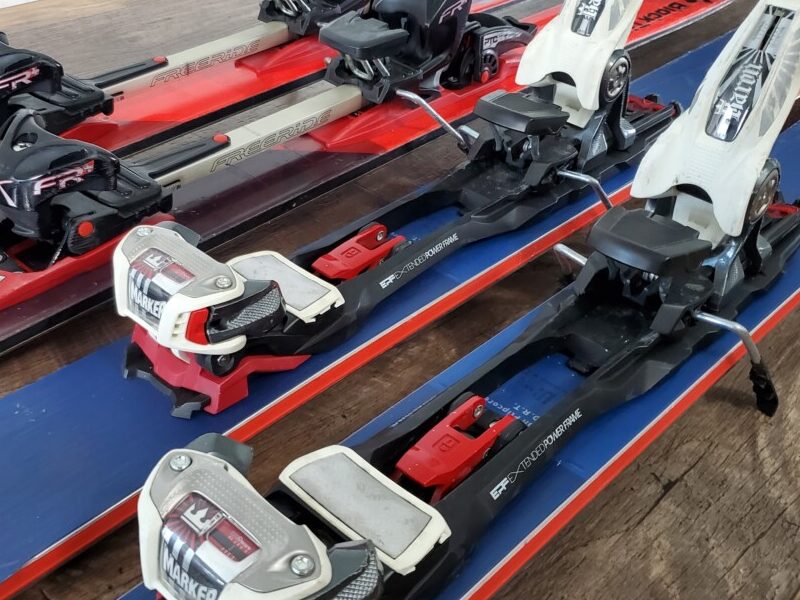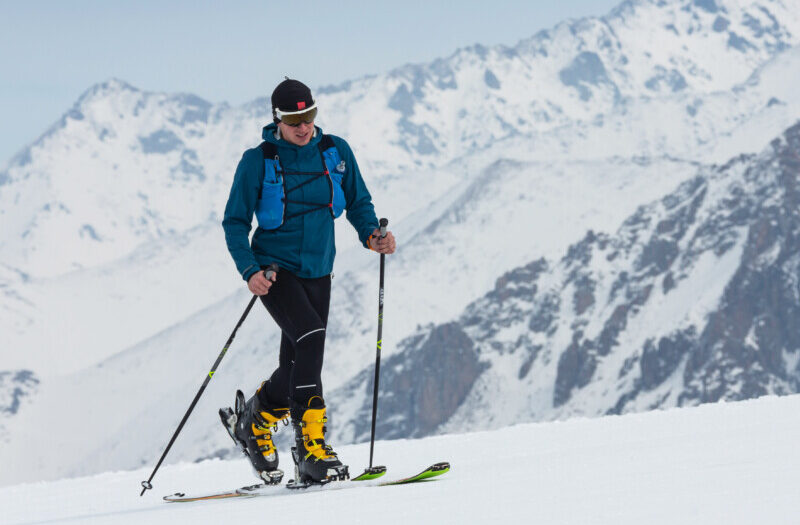
There are a lot of decisions to be made when gearing up for backcountry travel. Choosing between alpine touring bindings for the backcountry can be complicated, expensive, and often incorporates a tradeoff between downhill performance and weight. There are significant differences in how various alpine touring bindings fit, tour and ski. Choosing bindings is a decision you’ll want to get right to properly pair your skiing behavior with the set of bindings that will compliment your ambitions and fit within your budget.
Frame bindings can be an excellent affordable choice for those new to backcountry skiing or who favor sidecountry access from the lift. They provide excellent downhill performance with certified DIN release and do not require alpine touring boots with tech fittings.
Mandatory Disclosure: Before taking any tour in the backcountry, it is critical that you have taken the appropriate measures to become properly trained in avalanche risk assessment, mitigation and rescue–and other risks associated with backcountry travel. It is highly recommended that you take the AIARE 1 course as a prerequisite before venturing into the backcountry. You must also become properly equipped with all of the gear necessary for backcountry travel, rescue and recovery.
Once you are trained in avalanche awareness and backcountry safety, you’ll need to gear up. Choosing the right kind of bindings will be one of the decisions you’ll need to make. Tech, hybrid, and frame bindings all have different pros and cons and choosing between them will need to factor your overall budget and compatibility with the skis and boots the setup is intended to be paired with. You’ll also need to factor combined weight and the downhill performance of the combined setup.
Assess the following questions:
- Will the new setup be used as a mostly inbound quiver of one–with the occasional backcountry or sidecountry stint?
- Is the setup intended for more of a 50/50 split between inbounds downhill and alpine touring?
- Or, will the setup be used exclusively for backcountry travel?
If your realistic backcountry access needs are mostly centered around generating a “quiver of one-with the occassional backcountry or sidecountry stint”, frame bindings could be a great choice.
Alpine skiing requires a performance focused setup that can perform well through the myriad of different skiing conditions or specialize in one. Backcountry skiing incorporates significant uphill travel demands–sometimes more than 90% of the tour. When comparing the two activities, it is easy to recognize the polarized primary demands: performance vs. weight.
Unfortunately, Even though the technology in the ski industry is progressing rapidly, there just aren’t skis, boots, or bindings that absolutely dominate in both settings. The amount of weight carried on your feet while touring and how much demand is needed for downhill performance are still tradeoff decisions to be made.
Frame Bindings Offer Compatibility and Performance

A primary feature of frame bindings for alpine touring is that they are compatible with both alpine downhill and many AT (alpine touring) ski boots. And, they are compadible in both downhill and tour mode–unlike hybrid (Switch) bindings. Essentially, they do not require a ski boot with tech inserts in either heel or toe.
Additionally, ski boots mount onto frame bindings in the exact same way that alpine boots mount onto alpine bindings–set the toe of the boot into the binding’s toe cup, drive the heel down to engage the heel lever. Frame bindings are also equipped with an AFD (anti friction device) at the toe, just like on alpine bindings, and have a reliable DIN certified release mechanism.
This means that you do not have to purchase an expensive pair of alpine touring boots to begin touring in the backcountry. When touring on frame bindings with alpine boots, just loosten all the boot buckles and go.
This compatibility feature is exceptionally convenient for those that enjoy finding fresh untracked snow in the sidecountry accessed from the top of the lift. A skier can hit their favorite runs hard in the resort wearing their one and only pair of ski boots. Then, when the resort gets crowded or tracked out, they can grab their backcountry gear, ride up the lift, duck under the ropes and tour off-piste to find their secret stash of pow.
Frame Bindings: Please Stay, You’re Still Needed and Loved

Leading industry trends and the introduction of hybrid bindings have led some ski binding manufacturers to reduce their frame binding offering. I wish this wasn’t the case. Although the new hybrid bindings offer alpine DIN certified performance, they require tech-fitted alpine touring boots for touring.This adds a signifant entrance cost for those who are just cutting their proverbial teeth in the backcountry.
Also, the new hybrid bindings tout weight savings over frame bindings. However, when comparing a hybrid binding with some light weight frame bindings, the claimed weight advantages seem insignificant and begin to appear lackluster when one starts looking at the difference in price, complicated transitions, and fewer heal riser options associated with hybrid bindings.
For example, compare the hybrid Atomic Shift 13 MNC with both the Tyrolia Ambition 12 and the Black Diamond Fritschi Diamir Eagle 12 frame bindings in the chart below.
| Amazon Price | Weight/ each | DIN | Walking Modes | Step Out for Ski Mode Conversion? | |
| Atomic Shift 13 MNC (hybrid) | $599.99 +requires tech-fit boot | 885g | 6-13 | 2°, 10° | Yes. Required |
| Tyrolia Ambition 12 (frame) | $247.99 | 990g | 4-12 | 0°, 5°, 10°, 15° | Not Required |
| Black Diamond Fritschi Diamir Eagle 12 (frame) | $371.99 | 890g | 4-12 | 0°, 3°, 9°, 13° | Not Required |
Further below I provide a list of multiple frame bindings and a similar chart that compares price and features.
The bottom line is that Frame bindings have been and still are a great option for two types of consumers: those whose backcountry setup needs are primarily for sidecountry access, and those who want to transition into backcountry skiing without having to buy a whole new setup of skis, boots, and bindings.
Frame Bindings: Not Intended for Designated Backcountry Use
There are definitely some shortcomings with frame bindings when compared with designated backcountry bindings.
The toe piece on frame bindings has a pivot rocker that is connected via frame or rail to the heel piece that, when unlocked at the heel, allows for alpine touring. Their touring capability is decent. However, on some frame bindings, like the Marker F10/F12/Barron/Duke, the Salomon T Gaurdian, and the Tyrolia Ambition/Adrenaline-where the pivot point is located a little more out in front of the toe, they don’t have quite as natural a feel as touring with a tech style touring binding. That being said the Black Diamond Fritschi Scout-Eagle-Freeride frame bindings have a pivot slightly under the toe and tour more naturally.
Touring in frame bindings can be more clickety-clackety than a tech binding setup. The heel portion of the binding frame clangs against the ski with every footstep.
Frame bindings are heavier and beefier than most tech binding options. They can also be heavier and beefier than some alpine bindings. The bottom line is that they are “heavy” when juxaposed to tech bindings. Frame bindings would never be a go-to for someone seeking to put together a designated setup for the backcountry where weight becomes a more important factor than performance.
Setting Up for Backcountry Travel is a Progression for Many Enthusiasts that Leads to a Multi Ski Quiver
There is a lot of other equipment needed for backcountry travel such as: skins, beacon, shovel, probe, crampons, ice saw, etc. that require a significant investment. Not everyone can simply drop $5000 or $6000 on new everything all at once (wouldn’t it be nice though?)
Not only are frame bindings, in and of themselves, cheaper than many other binding options, they can be mounted on existing skis and they can be mounted with an existing set of alpine ski boots. Their affordability alone makes them a great starting point to segue into the backcountry.
For many, interest in the backcountry is a progression that escalates from one ski season to the next. And it goes without saying. . .the endorphins released during strenuous uphill travel combined with the adrenaline high from downhill turns all while saturated in isolated winter mountain bliss is second to none.
Subsequently, while interest and time in the backcountry increases, the need for lighter weight, backcountry exclusive equipment will increase as well and yearly purchases and upgrades are made with backcountry emphasis. Many backcountry enthusiasts end up having multiple sets of skis in their quiver to accomodate downhill vs. backcountry vs. variable ski conditions.
My personal downhill setup is equipped with a set of Marker Baron frame bindings (which I love). For those designated resort days–I’ll always have the option to venture into the sidecountry to find untracked snow.
For those who want to learn more about hybrid touring bindings (Salomon/Atomic/Armada Shifts, or Marker Duke PT), read more about hybrid touring binding’s pros and cons here.
And for those that are considering a purchase of frame bindings, check out the chart below where I’ve consolidated a lot of their key features and have included links to amazon.com for you to be able to look at them more closely:
Frame Bindings Compared
| Binding | Amazon Price | Weight/Each Grams | DIN/ISO Range | Boot Sole (mm) | Brake Width (mm) | Walking Modes | Step Out to Convert to Ski Mode? | Touring Pivot Angle | Adjust Heel Riser with Pole? |
|---|---|---|---|---|---|---|---|---|---|
| Black Diamond Fritschi Scout 11 | $397.00 | 790 g | 3 - 11 | S: 260-315 M: 285-340 L: 330-370 | 100 | 0°, 3°, 9°, 13° | NO | 90° | YES |
| Black Diamond Fritschi Diamir Eagle 12 | $371.99 | 890 g | 4 - 12 | S: 260-315 M: 285-340 L: 330-365 | 95 | 0°, 3°, 9°, 13° | NO | 90° | YES |
| Marker Tour F10 (2020) | $349.99 | 1056 g | 3 - 10 | S: 265-325 L: 305-365 | 90, 100 | 0°, 7°, 13° | YES | 90° | YES |
| Marker Tour F12 (2022) | $355.99 | 1096 g | 4 - 12 | S: 265-325 L: 305-365 | 100, 110 | 0°, 7°, 13° | YES | 90° | YES |
| Marker Baron EPF 13 (2022) | $334.99 | 1390 g | 4 - 13 | S: 265-325 L: 305-365 | 100, 110 | 0°, 7°, 13° | YES | 90° | YES |
| Marker Duke EPF 13 (2020) | $479.00 | 1390 g | 6 - 16 | S: 264-327 L: 305-365 | 90, 110, 130 | 0°, 7°, 13° | YES | 90° | YES |
| Salomon Guardian MNC 13 | $399.95 | 1495 g | 4 - 13 | S: 265-320 L: 305-360 | 90, 100, 115, 130 | 0°, 13° | NO | 90° | YES |
| Tyrolia Ambition 10 | $300.00 | 980 g | 3 - 10 | 260-350 | 85, 95, 105, 125 | 0°, 5°, 10°, 15° | NO | 90° | YES |
| Tyrolia Ambition 12 (2022) | $247.99 | 990 g | 4 - 12 | 260-350 | 85, 95, 105, 125 | 0°, 5°, 10°, 15° | NO | 90° | YES |
| Tyrolia Adrenalin 14 (2022) | $295.16 | 1360 g | 4 - 14 | S: 270-330 L: 300-360 | 85, 95, 105, 125, 130 | 0°, 7°, 13° | NO | 90° | YES |
If you see me on the slopes, you’ll see me on my frames, maybe with my pack, ducking under chains…off to find my stash of pow…off to find winter mountain bliss.